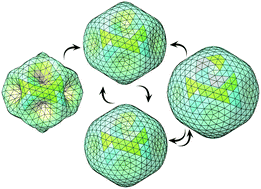Irreversible and reversible morphological changes in the ϕ6 capsid and similar viral shells: symmetry and micromechanics
Abstract
Understanding the physicochemical processes occurring in viruses during their maturation is of fundamental importance since only mature viruses can infect host cells. Here we consider the irreversible and reversible morphological changes that occur with the dodecahedral ϕ6 procapsid during the sequential packaging of 3 RNA segments forming the viral genome. It is shown that the dodecahedral shape of all the four observed capsid states is perfectly reproduced by a sphere radially deformed by only two irreducible spherical harmonics with icosahedral symmetry and wave numbers l = 6 and l = 10. The rotation of proteins around the 3-fold axes at the Procapsid → Intermediate 1 irreversible transformation is in fact also well described with the shear field containing only two irreducible harmonics with the same two wave numbers. The high stability of the Intermediate 1 state is discussed and the shapes of the Intermediate 2 state and Capsid (reversibly transforming back to the Intermediate 1 state) are shown to be mainly due to the isotropic pressure that the encapsidated RNA segments exert on the shell walls. The hidden symmetry of the capsid and the physicochemical features of the in vitro genome extraction from the viral shell are also elucidated.



 Please wait while we load your content...
Please wait while we load your content...